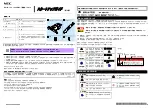
Intel Network Drivers for DOS
The NDIS2 (DOS) driver is provided solely for the purpose of loading other operating systems -- for example,
during RIS or unattended installations. It is not intended as a high-performance driver.
You can find adapter drivers, PROTOCOL.INI files, and NET.CFG files in the PRO100\DOS or
PRO1000\DOS directory on the Product CD or download folder. For additional unattended install information,
see the text files in the operating system subdirectories under the APPS\SETUP\PUSH directory.
Automatic or Explicit Configuration of a Single NIC or Multiple NICs
When the driver finds that only one adapter is installed in the system, it will use that adapter regardless of
whether or not parameters in PROTOCOL.INI are present or correct. If the parameters do not match the
actual configuration, the driver will display warning messages indicating that the parameter was not used.
One instance of the driver must be loaded for each adapter that is activated. When multiple adapters are
installed, the SLOT parameter becomes advisable but not required.
The determination as to which adapter each driver will control should be made by the user based on the
protocol stack(s) bound to each driver, and based on the network that is connected to each adapter. The
“BINDINGS” list in each protocol stack’s PROTOCOL.INI section establishes the relationship between
protocol stacks and drivers. The SLOT parameter in the driver’s PROTOCOL.INI section establishes the
relationship between drivers and adapters, and a value can be provided for each driver loaded. If a SLOT
parameter is not specified, the first driver instance will load on the first NIC/Port found in the scanning list, the
second driver instance will load on the second NIC/Port found in the scanning list, etc. When the driver
detects multiple NICs/Ports it will report all of the possible slots. The only way for the driver to know which
driver instance is being loaded is to use the DRIVERNAME parameter instance number. Therefore, it is
essential that the DRIVERNAME parameter instance syntax defined below be used correctly.
The adapters are automatically configured by the PCI system BIOS when the system boots. The driver
queries the PCI BIOS and obtains all of the adapter’s configuration information. BIOS scanning using
mechanisms 1 and 2, as defined in the PCI BIOS specification, are supported. The SLOT number is actually
the encoded value of the PCI adapter’s device location, which is defined as shown below. The SLOT value
reported by the driver and entered by the user is the value of bits 0 through 15. In versions of the driver prior to
2.01, the SLOT value reported by the driver and entered by the user was shifted right by 3 bits (divided by 8) so
that SLOT 0x0088 was actually entered into PROTOCOL.INI as 0x0011. This doesn’t allow for multi-function
devices to be specified with this SLOT parameter. So starting with v2.01, the driver does not shift the input
parameter by 3 bits and SLOT 0x0088 would be entered as 0x0088. This also allows for specifying slot
0x0081 = Bus 0 Device 16 Function 1. If the driver finds that the entered SLOT number is not found in its slot
list table, it may be because the SLOT uses the older convention (shifted right). The driver then tries to match
this old style slot parameter to a slot in the slot list and loads on that slot if it finds a match. This is done for
backward compatibility.
Configuring with the PROTOCOL.INI File
The configuration parameters listed below are supported through the PROTOCOL.INI file. When the machine
has a single adapter, all the parameters (except DRIVERNAME) are optional; when the machine has multiple
adapters, some of the parameters are required.
















































